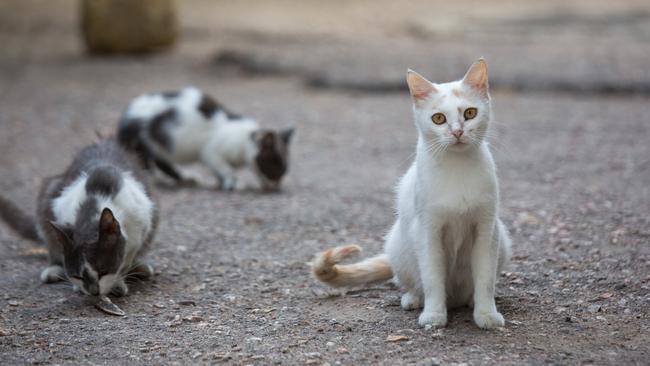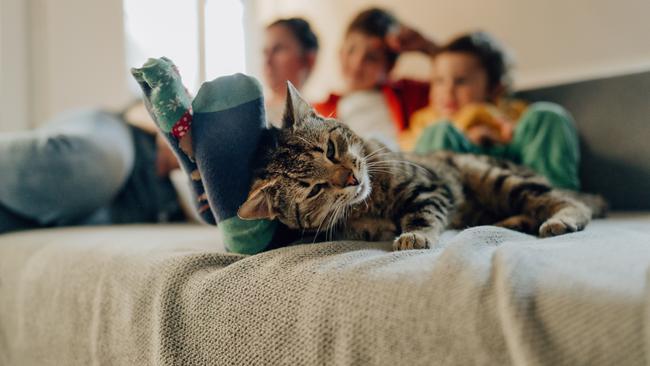Stiff fines for felines found out after curfew, as more councils opt to lockdown cats
Ten Victorian councils are set to join the existing 17 that have introduced tough cat lockdown laws with big fines for roaming moggies. See whether yours is one.

Victoria
Don't miss out on the headlines from Victoria. Followed categories will be added to My News.
Another 10 Victorian councils are set to join the existing 17 that have introduced tough cat lock-in laws, with the owners of felines found on the prowl being fined as much as $725.
Almost a quarter of metro councils now prohibit cats ever leaving their homes, with only four of 31 having rejected implementing curfews.
Council cat curfews steadily increased after the first confinement order was made in Mornington Peninsula in 1997.
There has been a sharp increase in curfews over the last two years, with Monash and Darebin councils implementing evening cat lock-ins in 2021 and with Knox and Port Phillip joining the list as recently as April this year.
Knox gained international attention with its decision to join the 24-hour lock-in cat club in April 2022, prompting the circulation of a petition that collected more than 3000 signatures protesting the new local laws.
Although full-time restrictions are technically containment laws, and curfews refer to confinement over a specific period, the term ‘curfew’ is often used interchangeably by councils.
The most expensive fine a cat owner can incur for a breach of curfew is $725 in Monash, if a repeat offender is found wandering the streets overnight. The only council to not impose fines for breach of curfew is Maroondah, a council spokesman told the Herald Sun.
Currently, 55 per cent of metro council areas have some kind of cat curfew or confinement orders in place.

Of the 14 out of 31 metropolitan councils that do not currently have curfews, 71 per cent are considering introducing them.
The only councils that are not presently reviewing curfews are Boroondara, Hobsons Bay, Banyule and City of Melbourne.
Mario Casalis, who has lived in Bundoora for 32 years and in that time has owned four British short hair cats, is in support of nigh time curfews.
Bundoora falls within Darebin council, which introduced a 7pm – 7am curfew in 2021.
“I was always under the impression that there was a curfew because of the wildlife in our area,” Mr Casalis said.
“I think it’s a good idea to have a night curfew – at the end of the day [cats are] an introduced species and if you keep them as a pet you should keep them indoors at night.”
Mr Casalis believes that as well as posing a larger threat to native fauna at night, keeping cats indoors also helps to keep them safe.
“There’s also traffic and you might live near a busy road and cats wander a bit. On Plenty Road you’d probably see half a dozen cats run over a year,” he said.
“It’s responsible cat ownership to implement your own cat curfew regardless of local laws.”
Although his current cat is an indoor moggy, Mr Casalis sympathises with cat owners who live in areas with 24-hour curfews. His last cat, Nigel, loved to roam the neighbourhood during the day.
“A 24 hour curfew would have been hard for Nigel, with male cats it’s all about controlling their territory and they’re more predominantly outdoor cats,” he said.
“He would have ripped the house apart (trying to get outside).”

In the Australian Capital Territory cat containment is now enforced territory-wide, requiring all cats born on or after 1 July 2022 to be contained on the owner’s premises 24-hours a day.
Agriculture Victoria (AV) said that there were currently 224,000 registered cats across Victoria with many more unregistered, unowned and feral.
An AV spokesman said cats posed a threat to native wildlife and biodiversity, having contributed to the extinction of more than 20 Australian mammals and the endangerment of species such as the numbat, bilby and bandicoot.
“We need to ensure we’re best supporting the welfare of cats as well as our native wildlife,” the spokesman said.
Cats which were securely confined to their property were not only less likely to kill native wildlife but also less likely to be hit by a car, injured in fights, catch fatal diseases or become lost.




